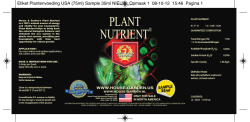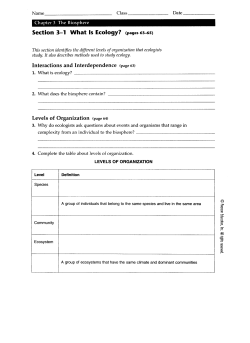
Aging Well With Nutrition: What to eat and how to eat it!
Aging Well With Nutrition: What to eat and how to eat it! Health Professionals Day Royal Agricultural Winter Fair Nov 11, 2009 Heather Keller RD, PhD, FDC Some Facts … Canada The World (in millions) 2056, 1 in 3 2000 1800 1600 1400 1200 1000 800 600 400 200 0 2005, 1.3 in 10 Over 65 years current 2020 2050 The Aging of Canada Source: Statistics Canada (2006) : Portrait of the Canadian Population in 2006, by Age and Sex: Data tables, figures, maps and animations (http://www12.statcan.ca/english/census06/analysis/agesex/tables.cfm#animations) Quantum Health Expectancy Theory (Barondess, 2008) • Certain quantity of life at birth • Environmental assaults • Healthful behaviours • Evidence: long-lived groups/cohorts • Common factors: social interaction, positive attitude, cognitive stimulation, diet/non-obese, non-smoking, none to limited alcohol, limit stress WHAT TO EAT? Dietary Reference Intakes & Older Adults • Very little research on requirements for older adults; extrapolation from younger age groups • Issue of differentiating needs due to age vs. change in requirements due to subclinical disease • TUL? Especially considering drug- nutrient interactions • Known changes with age that could influence • Loss of lean body mass – up to 30% ? Affect needs, how nutrients transported • Lower body water- ? Affect distribution of nutrients • Potential gastrointestinal changes- affect intake, atrophic gastritis? Absorption, utilization • Large hormonal changes- affect requirement via bioavailability, conversion, utilization • Increased bone resorption Vitamins • Increased need with age for B6 - pyridoxine phosphorylation • Atrophic gastritis highly associated with age; impairs B12 absorption • All age groups increased requirement for vitamin C and E from prior versions • Vitamin D increased for 51+ and 71+ Minerals/Trace metals • Calcium has increased requirement compared to younger ages • Sodium, chloride, iron (women) and chromium have lower requirements than younger ages • Phosphorus TUL is lower than other age groups • Trace metal needs potentially reduced to decreased body pool size What to eat.... • Nutrient requirements for the most part are the same or greater for the healthy older adult group • Older adults need high quality, nutrient dense diets • Caloric needs greatly reduced, primarily due to decreased activity and loss of LBM • CAREFUL planning! Is there a concern? • Poor intake of all four food groups (Quebec, British Columbia, New Brunswick, Ontario and Canadian Community Health Survey) • • • • A variety of nutrients consumed at low levels Protein and energy Involuntary weight loss Voluntary weight loss EWCFG Recommendations for Food Groups Food Group Vegetables and Fruit Grain Products Milk and Alternatives Meat and Alternatives Oils and Fats EWCFG 51+ age group Male Female 7 7 7 6 3 3 3 2 2-3 tbsp 2-3 tbsp Tuft’s University Modified Pyramid for Older Adults Heterogenity of Older Adults The challenge of frailty • What are the needs? • Diagnosing potential deficiency… • Planning for adequate intakes HOW TO EAT? NuAGE Diet Resilience Study Shatenstein et al, 2009 Quality of food Getting Food to the Senior Wanting to eat What do Social Relationships Do? Rook 1985 & Pierce 2000 Social Integration Regulation, promote healthy behaviour Social Support Response to a Stressor Companionship -Emotional/Encourage Promotes Self Worth -Informational Camaraderie -Tangible Emotional sharing Intimacy & pleasure IMPROVED FOOD INTAKE Life Nourishment Theory (Keller et al., 2009) Living Life to the Fullest with Dementia Being connected Mirroring the way we are Adapting to an Evolving life Honouring identity Existing with Dementia Having dignity Being accepted Being acknowledged Having values Veiling reality Honouring family and individual identity Having meaningful roles Enabling roles Negotiating capacity Reaffirming Self in the world Having routines & traditions Making decisions Reminiscing Keeping informed Creating new stories Honouring identity “As a mother that was really important to me to still have that. Because mothers and parents tend to do that for their children so that was another thing I didn’t want to lose.” PWD “…you get back into discussing the past, the history of the family or what we did, do you remember what we did back in 1972 sort of thing…” CG back Being Face to Face Taking time Taking Part Focusing attention Being Connected Participating Psychologically Sharing activities & interests Making plans & decisions Learning from others Being creative Getting and Giving Support Physical Psychological Emotional ‘But I would say I feel that we’re the most connected then, when we’re sitting across from each other at a table. I think a lot of it is we’re facing each other’ (CP24). ‘opportunity to communicate, to clarify, to reaffirm our positions and situations, caring for each other, and learning something, all of those things. That is a good, the mealtime is a great place for that’ (PWD6). Older Adults and Eating Together • Eating together can: – improve nutrient intake and reduce malnutrition – stimulate social relationships – facilitate social bonds – improve QOL – provide emotional support Refs: Nijs et al., 2006 ; Locher et al., 2005; Hubbard et al., 2003 ; Rook, 1985 ; Amella, in press What does this mean? • How we eat is important… - may lead to diet resilience, ability to adapt, better quality diets • Leads to feelings of well-being and quality of life • In some cases this sense of well-being is more important than what is consumed • Advanced dementia • End of life • Need to consider ‘how we eat’ in communal eating situations • Are we promoting connection? • Are we honouring identity? • If mealtimes are ‘the way we are’ perhaps mealtimes can change who we are Takeaways • What to eat, for older adults is a challenge… – Heterogeneity – Knowledge shadow – Should we supplement? • As with any age group, older adults struggle with ‘eating well’; choosing foods for health • We have to remember that how one eats, is also important to the health picture
© Copyright 2025





















